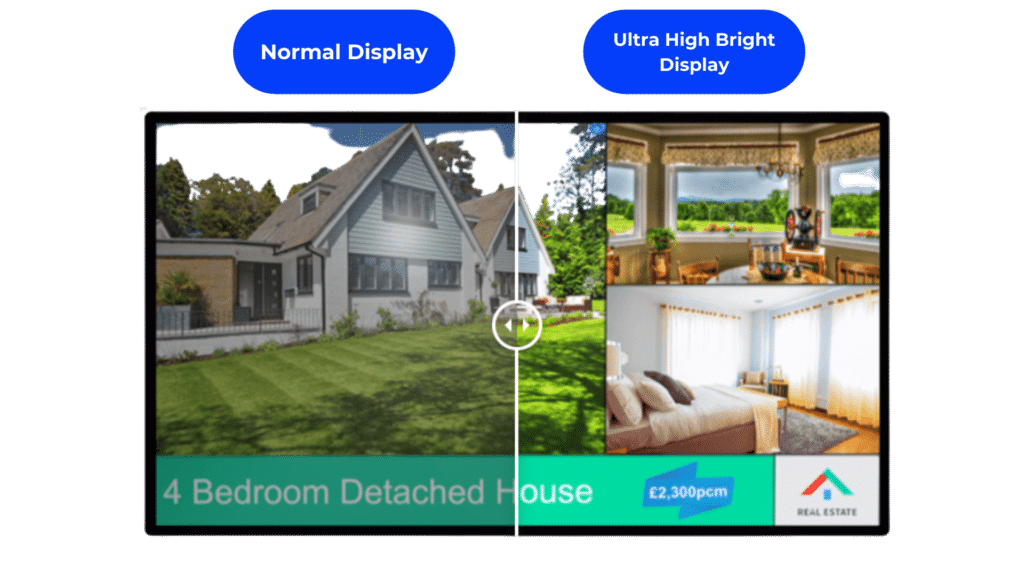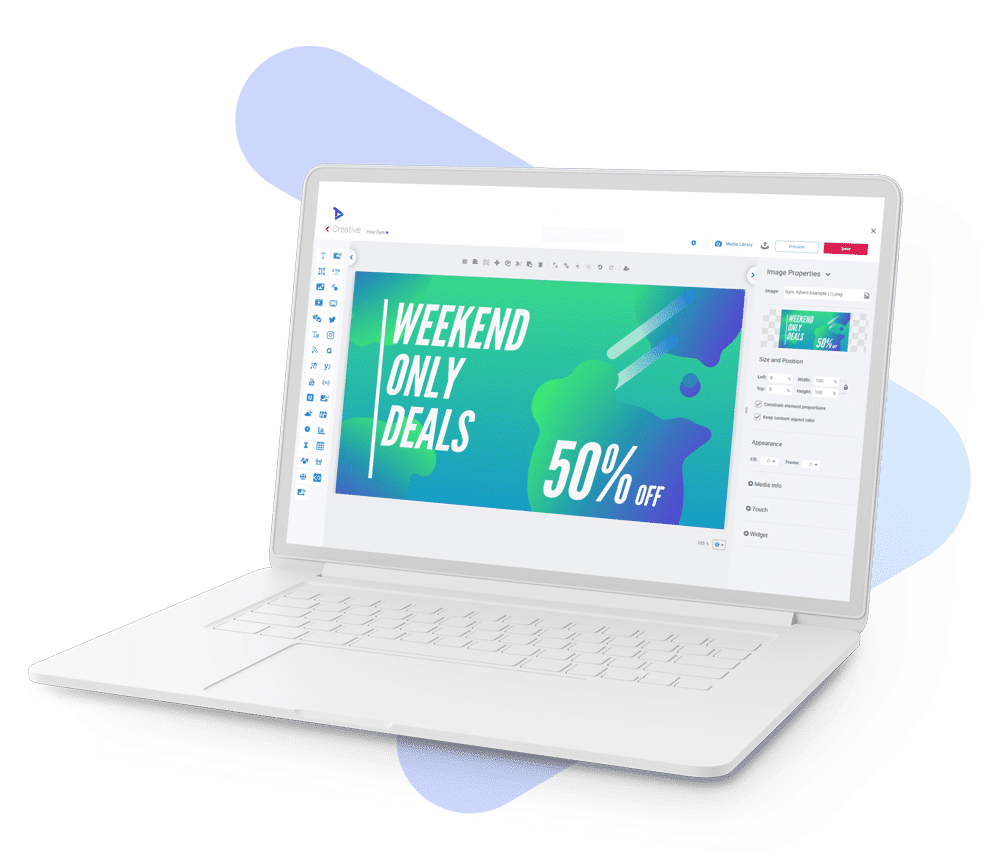Digital signage is rising in popularity throughout various sectors, including hospitality, retail, healthcare, leisure, corporate, and education. While digital signage has many benefits, knowing how to optimise your signage is crucial for success. Common digital signage mistakes could make or break your campaign.
Too often, businesses fail to use digital signage capabilities to their maximum capacity, reducing their potential return on investment (ROI). Ensure your digital displays are eye-catching, versatile, effective, and efficient by avoiding these 8 common digital signage mistakes.
1. Using The Wrong Screen Brightness
Screen brightness can hugely impact the success of a digital signage campaign. If your screen brightness is too low, for example, customers will not be able to read or view your screen with ease, reducing its potential reach. This issue is prevalent in digital window displays that, when in direct sunlight, are too dark.
Solve this issue by adopting high-brightness digital screens. A high-brightness screen is a digital display designed to function within bright areas. High bright displays ensure that your screen is visible at any time of day, even in direct sunlight. It also reduces glare. Avoiding this brightness feature is one of the digital signage mistakes you do not want to make; this investment can boost your sales.
Additionally, adopting automatic brightness controls for your screens allows them to adjust their brightness to different daylight hours and levels. For example, at night or on a gloomy day, a screen can automatically reduce its brightness level to not blind passers-by yet maintain its visibility. This functionality also saves energy.

2. Displaying Impersonal And Unbranded Content
Businesses are always looking for ways to improve the efficiency of their business operations and communication. Despite this, cutting corners in crucial areas can be detrimental to your interaction with customers. With marketing communications often coming top-down, it is an easy option for staff to display this straight onto the screen – this is alienating for customers.
To avoid this, add an element of personalisation to your content. Efficiency is about balancing time and effectiveness – if you are simply displaying top-down messages, your ROI will suffer. Customise content to fit the local area and the people using your business, for example, add a language translation or local phrase. This content will ensure your messages are memorable and generate a higher conversion rate, increasing business efficiency.
Similarly, avoid unbranded content. You want customers to remember your brand, as well as the message you are translating. Cloak your digital signage content with brand colours, fonts, and style to make it memorable, even after the customer has left your business.
By combining personalisation and branding, you will avoid the digital signage mistakes many make in alienating and losing customers.
3. Not Guiding Customers In Their Journey With Your Business
Digital signage is eye-catching and influential. Content can improve customer and viewer understanding of a brand, product or service, informing, educating, and entertaining. Despite this, by not telling customers the next step after viewing your content, you can jeopardise your whole digital signage campaign; customers will move on from your screen lost.
To avoid this customer cluelessness, include a call to action (CTA) on-screen. A CTA is a phrase or device that tells the viewer what action to take next – a game-changing content idea for digital signage and what customers want.
Enhance your CTA with personalisation. Personalised CTAs convert 42% more viewers into leads than generic CTAs. Achieve this by using imperative verb forms, such as “you”. For example, “Sign up now to get your 10% discount”. Alternatively, display a scannable QR code with the CTA “scan me for more information” to deliver information straight from your signage to a customer’s mobile device.
For businesses, a CTA creates a way to convert consumers to customers and measure success. For customers, it guides their journey with your business, making their experience smoother and satisfaction higher.

4. Receiving Poor Support From Your Software Provider
Like all technology, sometimes things do not go to plan, or you need some extra support. A common digital signage mistake businesses make in choosing a software provider is selecting one that fails to be on hand to resolve issues quickly and give you the support you need to maintain the very best on-screen content.
To ensure you have the support you need, select a software provider that will attend to your issue in a flash. A provider with a support team that can access your screens remotely in seconds is key to solving problems quickly and, thus, reducing the downtime of your screens.
Support not only comes in solving issues, however; it also comes in setting up your screens and providing training sessions to ensure you get the most out of your purchase.
By selecting a provider that prides itself on the support they give, you will ensure your ROI remains high, and customers never fail to be engaged with your digital signage content.
5. Neglecting The Capabilities Of Digital Signage
One of the key benefits of digital signage is the ability to display multimedia content. Digital signage content includes videos, live TV, animations, images, social media, text, and more.
However, a common mistake businesses make is purchasing digital signage and simply displaying static content. While customers may have their heads turned by the bright screen and easy-to-read text, more than a static print poster, they will be uninspired.
Avoid this digital signage mistake by making the most of multimedia capabilities, for example, delivering video product tutorials, or rotating service images. In fact, research has shown that viewers are 64-84% more likely to buy a product after watching a video, accentuating the benefits of maximising your use of all the features digital signage software has to offer.

6. Not Measuring Success
Each digital signage project has different goals. Some businesses may aim to increase product awareness or improve customer experience. Others will want to save paper usage or expand social media reach via digital signage.
A massive digital signage mistake businesses make is not measuring the success of their signage campaign. Without trackable key performance indicators (KPIs), a company will not know if they are meeting their goals and, thus, how to improve.
To avoid this blindness, from the very start, plan your goals and how you will measure these. These KPIs could include the number of app downloads from a QR code, the number of times someone approaches a staff member due to a CTA, or the number of trees saved from minimising paper usage. Thus, get personal and think about how each KPI would benefit your business.
7. Failing To Update Content
One of the key benefits of digital signage is the ease at which you can update content using digital signage software. This content then appears on-screen right away. Despite this, even good-looking content requires change and rotation. For regular customers visiting your business, repetitive content becomes monotonous and uninspiring, leading to stagnant sales.
Prevent this digital signage mistake from happening by training staff members within your business to use the digital signage software to update content immediately and schedule new content. Moreover, by scheduling content, you can create a calendar of content that aligns with your business strategy.
Do not slack with fresh content; new promotions, products, and services keep customers interested and coming back for more.

8. Choosing The Wrong Screen Location
Digital signage is a versatile and eye-catching method of marketing and communication. High-brightness screens and multimedia content have the power to capture attention, even from passers-by. Despite this, simply placing your digital screen on a free wall or somewhere irrelevant will reduce the reach and effectiveness of your campaign.
Maximise the potential of your digital signage by planning its location and thinking about where your audience can be found and targeted. For example, place a screen in a waiting area or at the point of sale. Also, always ensure content is visible and not blocked by pillars, furniture, or even masses of people. This placement ensures that your content is maintaining a high ROI and reaching the people it needs to.
Additionally, think about the type of digital signage hardware you are using. For example, if people need in-depth maps and directions, do not just place a digital screen on the wall. Situate a touchscreen digital kiosk in prime areas that customers can interact with. Similarly, in a fast-food restaurant, for improved efficiency, do not just place a digital menu on the wall. Instead, provide customers with centralised digital kiosks presenting menus with integrated e-commerce.
By thinking about screen placement and type, you can maximise the reach of your content and meet your business goals.
If you have any questions related to digital signage mistakes and how to avoid them, speak to an expert today. Call our friendly team on 02380 981110 or Email info@troudigital.com for a no-obligation consultation. Alternatively, click the button below.
